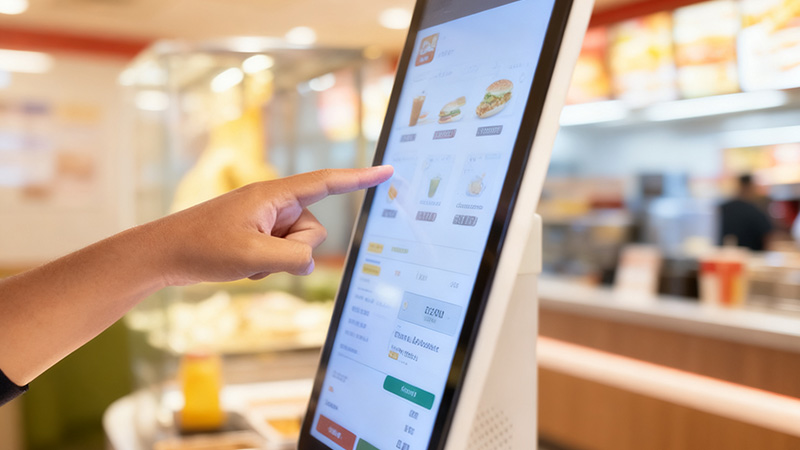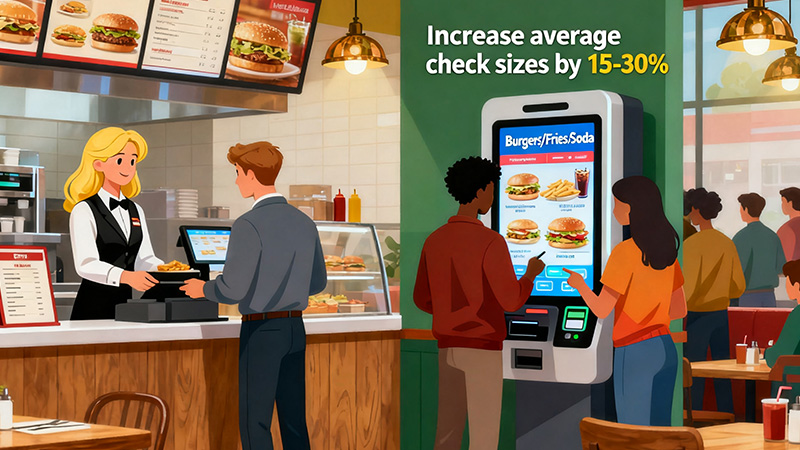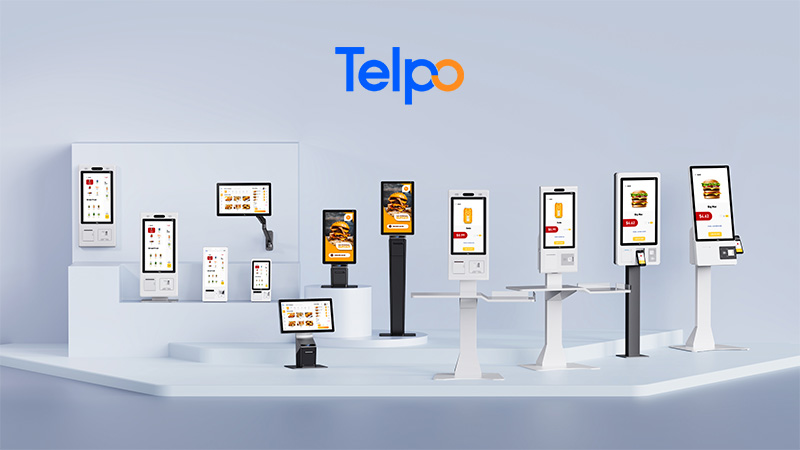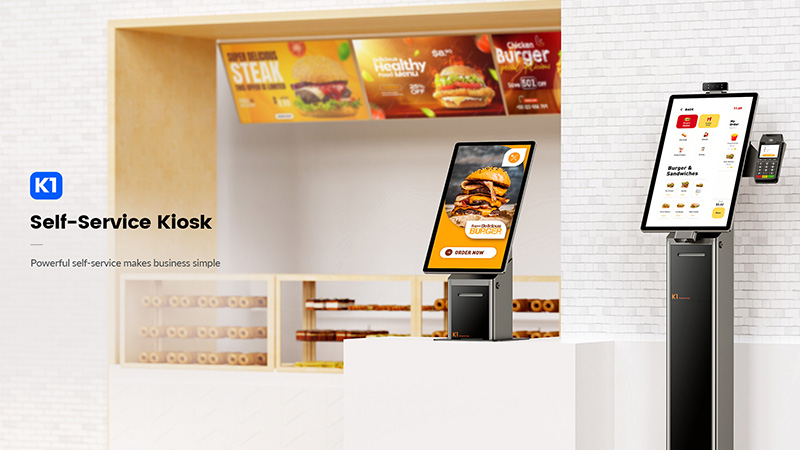The quick-service restaurant (QSR) industry is experiencing a digital revolution, with self-service technology leading the charge. Recent data from Qu’s 2025 State of Digital report shows that 62% of restaurant brands now use or plan to adopt kiosk technology, up from 43% just a year ago. According to Qu’s latest announcement about their kiosk system upgrades, restaurants implementing these solutions are seeing measurable increases in average ticket sizes compared to traditional counter service. For QSR operators seeking competitive advantages, understanding how ordering kiosk machines drive revenue while solving staffing challenges has become essential.

Photo: Generated with AI
The Revenue-Boosting Power of Touch Screen Ordering Kiosks
Digital ordering kiosks fundamentally change how customers interact with menu offerings, creating multiple revenue opportunities that traditional ordering methods cannot match.

Increased Order Values Through Suggestive Selling
Food ordering kiosk machines excel at upselling and cross-selling without the awkwardness of human pressure. Customers take their time browsing menu options, exploring add-ons, and customizing orders. Studies consistently show that self-service ordering systems increase average check sizes by 15-30% compared to counter orders. The digital interface presents compelling visuals of menu items, add-ons, and combo options at optimal decision points throughout the ordering journey.
Elimination of Order Errors
Manual order-taking creates costly mistakes—wrong items, missed customizations, or miscommunicated special requests. A kiosk machine for restaurants eliminates these errors by allowing customers to input their exact preferences directly into the system. This accuracy reduces waste, improves customer satisfaction, and protects profit margins that would otherwise be lost to remakes and refunds.
Peak Hour Revenue Optimization
During rush periods, traditional counter service creates bottlenecks that limit transaction volume. Multiple touch-screen ordering kiosks operating simultaneously can process significantly more orders than a single cashier line, capturing revenue that would otherwise be lost to customers who leave due to long wait times.
Operational Efficiency of Digital Ordering Kiosks: Solving the Staffing Crisis

The restaurant industry faces persistent labor challenges—high turnover, rising wages, and difficulty finding qualified staff. Self-service kiosk companies are providing solutions that directly address these pain points.
Labor Cost Reduction and Reallocation
Food kiosk machines don’t replace staff entirely; they redeploy them more strategically. Instead of standing at registers entering orders, employees can focus on food preparation, quality control, table service, and customer hospitality—tasks that genuinely require human judgment and create memorable experiences. As Brian Crum, VP of Product at Qu, notes, reducing time on repetitive screen tasks allows employees to focus on faster-paced, hands-on work requiring coordination and human touch.
Flexible Workforce Management
Modern self-service ordering systems offer operational flexibility. Advanced terminals can switch between staff-operated and customer-facing modes based on traffic patterns, allowing managers to adapt quickly during unexpected rushes or staff shortages. This flexibility also broadens hiring possibilities, accommodating employees with varying comfort levels for direct customer interaction.
Consistent Brand Experience
Human staff have off days, varying product knowledge, and individual communication styles. A self-service machine delivers identical brand messaging, upselling prompts, and menu information to every customer, every time—ensuring consistency that builds brand trust and customer loyalty.
Implementing Kiosk Solutions: What QSR Operators Need

Successful kiosk deployment requires more than just purchasing hardware. Restaurant operators should consider several critical factors:
Integration Capabilities
Your digital ordering kiosks must seamlessly connect with existing POS systems, kitchen display screens, payment processors, and loyalty programs. Fragmented systems create operational headaches and data silos that undermine the efficiency gains kiosks promise.
Customization and Scalability
Every restaurant has unique spatial constraints, brand aesthetics, and operational requirements. The ideal kiosk machine solution offers modular configurations—various screen sizes, multiple installation options (countertop, floor-standing, wall-mounted), and expandable functionality through accessories like payment modules, receipt printers, and biometric scanners.
Performance and Reliability
QSR environments are demanding—high transaction volumes, varying lighting conditions, and constant use. Look for solutions built on robust platforms with powerful processors and commercial-grade components that withstand continuous operation without lag or downtime.
Telpo’s Food Kiosk Machine Solution: Purpose-Built for QSR Success

For operators ready to implement self-service technology, Telpo’s kiosk machine solution addresses the specific needs of quick-service environments. The platform supports various screen sizes and installation methods to fit any restaurant layout, while advanced Android systems with high-performance processors ensure smooth, responsive operation during peak hours.
What distinguishes this self-service kiosk approach is its capability for modular customization. Restaurants can configure systems precisely for their operational requirements—integrating payment modules for seamless transactions, adding printing systems for order confirmations, or incorporating biometric scanners for loyalty program authentication. A dedicated R&D team provides rapid technical support, ensuring minimal downtime.
Spotlight: Telpo K1 Self-Service Kiosk

The Telpo K1 self-service touch screen kiosk exemplifies next-generation restaurant technology. Running Android 14 with an octa-core processor, it delivers exceptional responsiveness even during complex ordering workflows. Its 21.5-inch ultra-narrow bezel display (just 14.5mm borders, 10mm at the thinnest point) creates an immersive customer experience, while 400-nit brightness ensures crystal-clear visibility in any lighting condition.
The K1’s modular design enables extensive customization through Pogo Pin expansion ports for dual-lens face cameras, barcode scanners, and array microphones. POS bracket installation supports secure payment processing via EMV modules, including Ingenico Lane3600 and RX7000, while bank card readers accommodate various payment preferences. This self-payment machine flexibility means restaurants can start with essential functions and expand capabilities as their needs evolve.
Future-Proofing Your Restaurant with Food Ordering Kiosk Machine Technology
The trajectory is clear: digital ordering is becoming standard rather than novel. Early adopters gain competitive advantages through higher revenue per transaction, improved operational efficiency, and enhanced customer experiences. The technology has matured beyond the experimental phase—proven solutions now deliver measurable ROI within months of deployment.
For QSR operators evaluating options, prioritize solutions offering genuine customization, robust integration capabilities, and responsive technical support. The right self-service payment machine becomes a strategic asset, not just a cost-saving tool—driving revenue growth while solving labor challenges that threaten profitability.
Ready to explore how ordering kiosk machines can transform your restaurant operations? Discover Telpo’s self-service machine solution designed specifically for quick-service environments, or learn more about the flagship self-service payment machine that’s helping restaurants worldwide optimize their digital ordering experience.

